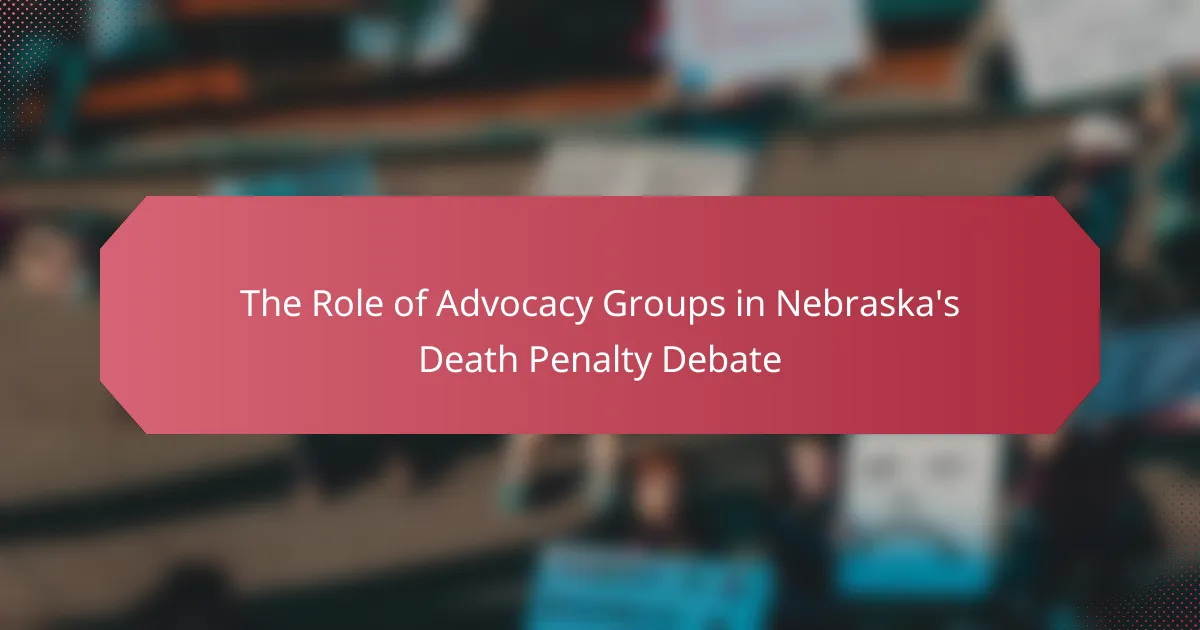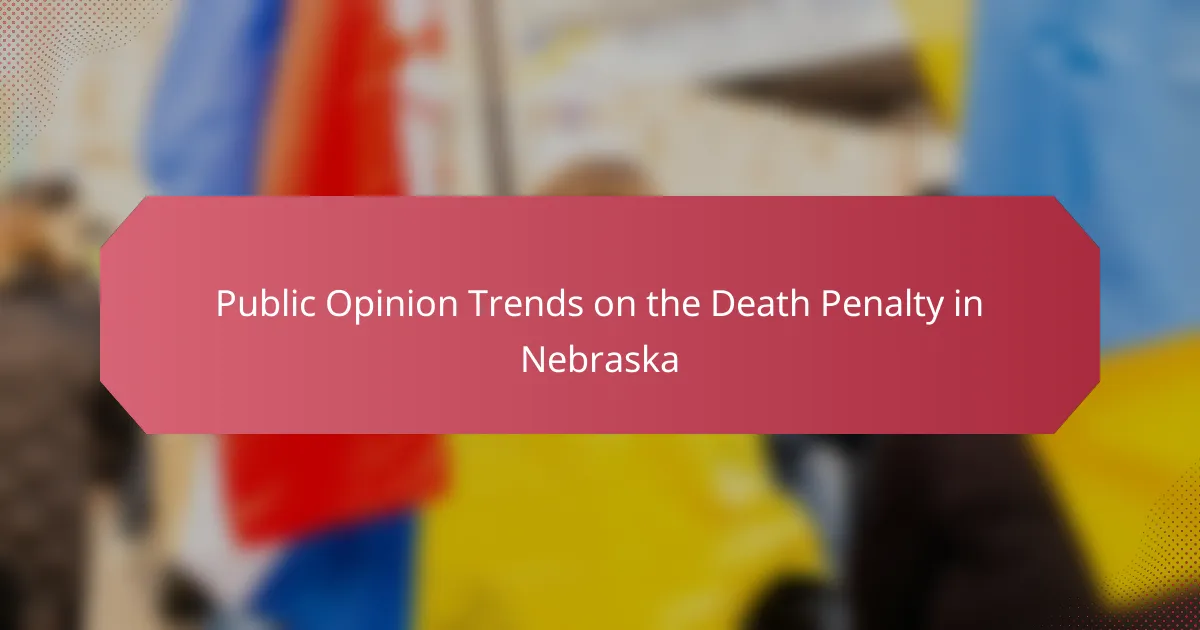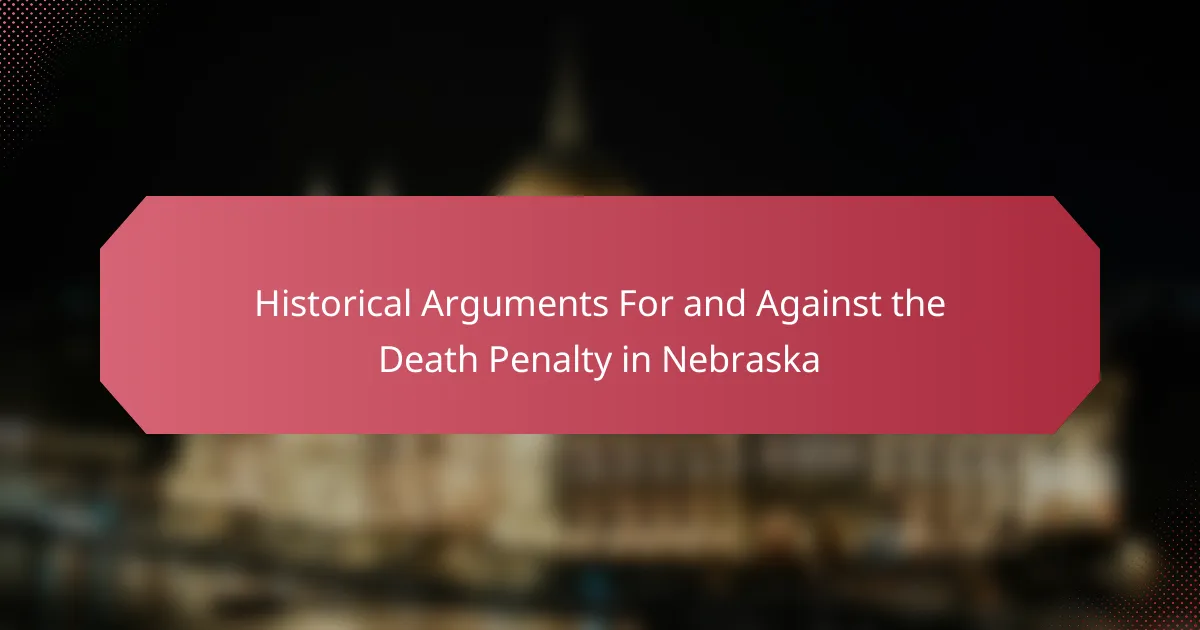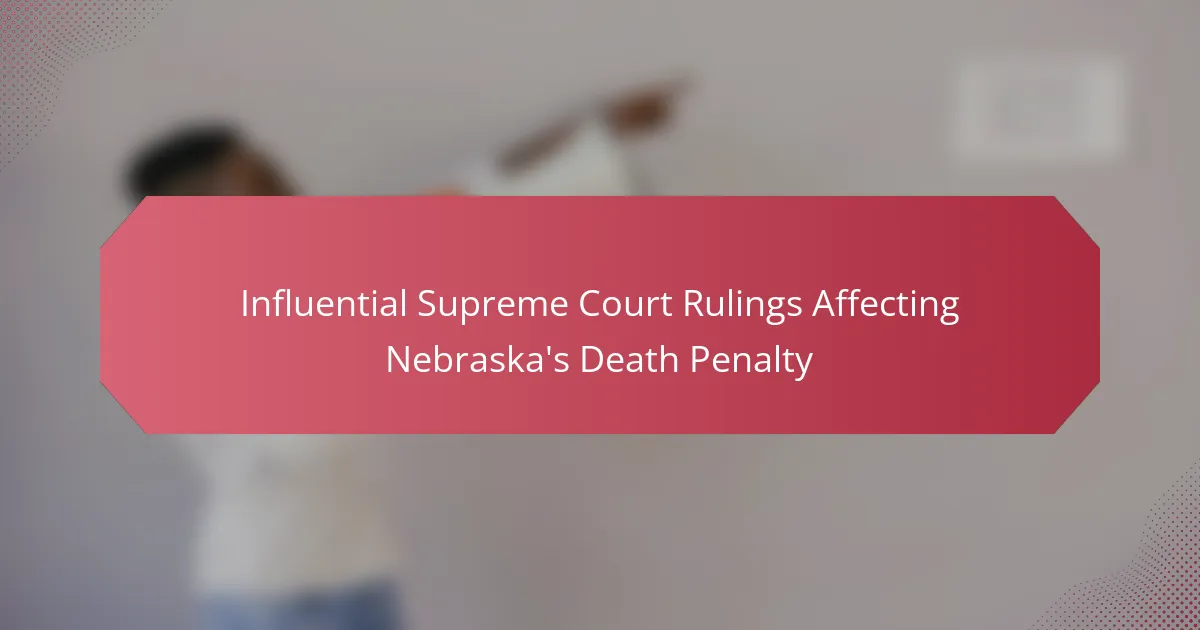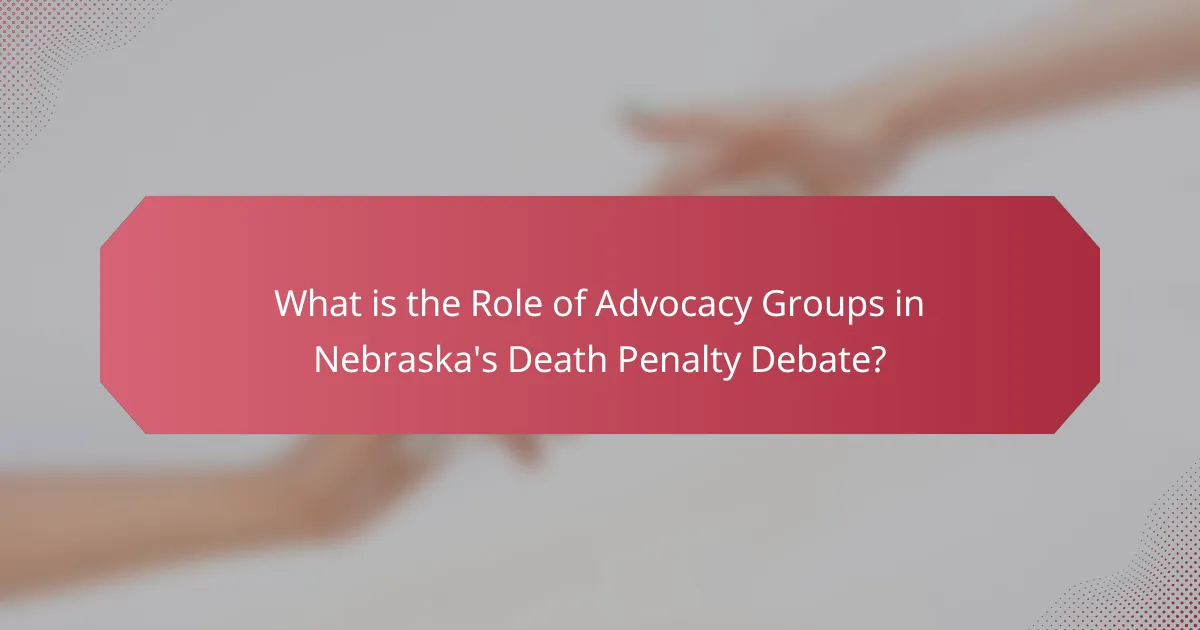
What is the Role of Advocacy Groups in Nebraska’s Death Penalty Debate?
Advocacy groups play a significant role in Nebraska’s death penalty debate. They influence public opinion and legislative decisions. These groups often represent diverse perspectives, including pro-death penalty and anti-death penalty stances. Advocacy organizations mobilize supporters to campaign for their positions. They engage in lobbying efforts to sway lawmakers. They also provide research and resources to inform the public. For instance, groups like Nebraskans for Justice advocate for reform and abolition. Their efforts have led to changes in legislation and public awareness.
How do advocacy groups influence public opinion on the death penalty in Nebraska?
Advocacy groups influence public opinion on the death penalty in Nebraska through education, lobbying, and media campaigns. They provide information about the moral, legal, and financial implications of capital punishment. These groups often highlight wrongful convictions and the risk of executing innocent people. They also mobilize community members to participate in discussions and rallies. By engaging with lawmakers, they advocate for policy changes. Surveys indicate that public awareness raised by these groups can shift opinions. For example, a 2015 survey showed a decline in support for the death penalty as awareness of its issues increased. Their efforts contribute to ongoing debates and legislative actions regarding capital punishment in the state.
What strategies do advocacy groups use to communicate their messages?
Advocacy groups use several strategies to communicate their messages effectively. They often utilize social media platforms to reach a wider audience quickly. This allows them to share information, updates, and calls to action in real time. Public demonstrations and rallies are also common strategies. These events help to raise awareness and engage community members directly.
Additionally, advocacy groups often create informative materials such as brochures and fact sheets. These resources provide detailed information about their positions and objectives. Engaging with the media is another critical strategy. By issuing press releases and participating in interviews, they can shape public discourse.
Collaborating with influencers or local leaders amplifies their reach. This partnership can lend credibility and attract attention to their causes. Finally, advocacy groups often conduct research and publish reports. This data-driven approach helps to support their arguments and persuade stakeholders effectively.
How do advocacy groups mobilize supporters for their causes?
Advocacy groups mobilize supporters for their causes through strategic outreach and engagement efforts. They utilize social media platforms to raise awareness and connect with potential supporters. Email campaigns are often employed to inform and rally individuals around specific issues. Organizing events, such as rallies and informational sessions, helps to create a sense of community and urgency. Partnerships with local organizations can expand their reach and influence. Additionally, advocacy groups often provide resources and training to empower supporters to take action. Research shows that personal stories and testimonials significantly enhance engagement and motivate action. These methods collectively strengthen the movement and increase public participation in advocacy efforts.
What are the key advocacy groups involved in Nebraska’s death penalty debate?
Key advocacy groups involved in Nebraska’s death penalty debate include the Nebraska Coalition to End the Death Penalty and the ACLU of Nebraska. The Nebraska Coalition to End the Death Penalty focuses on abolishing capital punishment in the state. They advocate for alternatives to the death penalty and raise public awareness about its implications. The ACLU of Nebraska engages in legal advocacy against the death penalty, citing concerns over its fairness and effectiveness. These organizations work collaboratively with other local and national groups to influence policy and public opinion regarding capital punishment in Nebraska.
What are the missions and goals of these advocacy groups?
Advocacy groups in Nebraska’s death penalty debate aim to influence legislation and public opinion regarding capital punishment. Their missions include promoting alternatives to the death penalty and advocating for its abolition. Many groups focus on raising awareness about the moral, legal, and financial implications of capital punishment. They seek to educate the public on the risks of wrongful convictions and the disproportionate impact on marginalized communities. Additionally, these organizations often work to support victims’ families and promote restorative justice initiatives. Their goals include mobilizing grassroots support and lobbying lawmakers for policy changes. Evidence of their impact can be seen in shifts in public sentiment and legislative proposals regarding the death penalty in Nebraska.
How do these groups differ in their approaches to the death penalty?
Advocacy groups differ significantly in their approaches to the death penalty. Some groups, such as those advocating for abolition, argue that the death penalty is inhumane and ineffective as a deterrent. They emphasize the risk of wrongful executions and the moral implications of state-sanctioned killing. In contrast, pro-death penalty groups assert that it serves as a necessary tool for justice and public safety. They believe it provides closure for victims’ families and deters serious crimes. Evidence from various studies indicates that public opinion varies widely, influencing the strategies employed by these groups. For instance, a 2020 Gallup poll showed that support for the death penalty fluctuated based on demographic factors, affecting advocacy tactics.
What challenges do advocacy groups face in the death penalty debate?
Advocacy groups face significant challenges in the death penalty debate. One major challenge is public opinion, which can be deeply divided on this issue. Many advocacy groups struggle to change perceptions about the morality and effectiveness of capital punishment. Legal obstacles also present difficulties, as advocacy efforts often confront established laws and judicial precedents. Additionally, funding limitations hinder the ability of these groups to sustain their campaigns and outreach.
Another challenge is the political landscape, where legislators may be resistant to reform due to fear of backlash from constituents. Advocacy groups also face competition from well-funded opposition groups that promote pro-death penalty narratives. Furthermore, misinformation can spread easily, complicating efforts to provide accurate information to the public. These factors collectively impact the effectiveness of advocacy groups in influencing the death penalty debate.
How do legal and political barriers affect advocacy efforts?
Legal and political barriers significantly hinder advocacy efforts. These barriers can include restrictive laws, regulations, and political opposition. Advocacy groups often face challenges in mobilizing support due to these obstacles. For instance, laws that limit campaign financing can restrict the resources available for advocacy. Political opposition may lead to unfavorable legislation that undermines advocacy goals. Additionally, legal frameworks can impose limitations on free speech and assembly, impacting advocacy activities. In Nebraska, these barriers have influenced the effectiveness of groups opposing the death penalty. Historical context shows that legal restrictions have often stifled public discourse on contentious issues like capital punishment.
What role does funding play in the effectiveness of advocacy groups?
Funding is crucial for the effectiveness of advocacy groups. It enables them to conduct research, mobilize supporters, and influence policy. Adequate funding allows for the hiring of skilled staff and the creation of strategic campaigns. Advocacy groups with substantial financial resources can reach a wider audience through advertising and outreach efforts. They can also engage in lobbying activities to sway lawmakers. For example, groups opposing the death penalty often require funds for legal support and public awareness initiatives. According to a study by the National Council of Nonprofits, organizations with robust funding are more likely to achieve their goals and sustain their operations. Thus, funding directly impacts the capacity and influence of advocacy groups in critical debates, such as Nebraska’s death penalty discussion.
How do advocacy groups collaborate with other organizations in this debate?
Advocacy groups collaborate with other organizations in Nebraska’s death penalty debate by forming coalitions. These coalitions unite various stakeholders to amplify their voices. They share resources, research, and strategies to enhance their impact. For example, groups may partner with legal organizations to provide expert testimony. They also work with community organizations to raise public awareness. Joint campaigns can mobilize grassroots support effectively. Collaboration often leads to coordinated lobbying efforts at the state legislature. This approach increases the likelihood of influencing policy decisions.
What partnerships are crucial for advocacy success?
Collaborations with key stakeholders are crucial for advocacy success. These partnerships include alliances with grassroots organizations, legal experts, and policymakers. Grassroots organizations mobilize community support and raise awareness. Legal experts provide insights into the legal framework and implications of advocacy efforts. Policymakers are essential for enacting change through legislation. Collaborating with media outlets enhances visibility and public engagement. Partnerships with academic institutions can lend credibility through research and data. Engaging with influential community leaders can drive broader support. These strategic partnerships strengthen advocacy campaigns and increase their effectiveness.
How do coalitions enhance the impact of advocacy efforts?
Coalitions enhance the impact of advocacy efforts by uniting diverse organizations and individuals towards a common goal. This collective strength amplifies the voice of the advocacy movement. By pooling resources, coalitions can increase funding, outreach, and influence. They enable sharing of best practices and strategies among members. Collaboration often leads to more comprehensive messaging and a broader reach. Research indicates that coalitions can lead to higher success rates in policy change. For example, a study by the National Council of Nonprofits found that coordinated efforts result in a 30% increase in advocacy effectiveness. Therefore, coalitions significantly enhance the capacity and impact of advocacy initiatives.
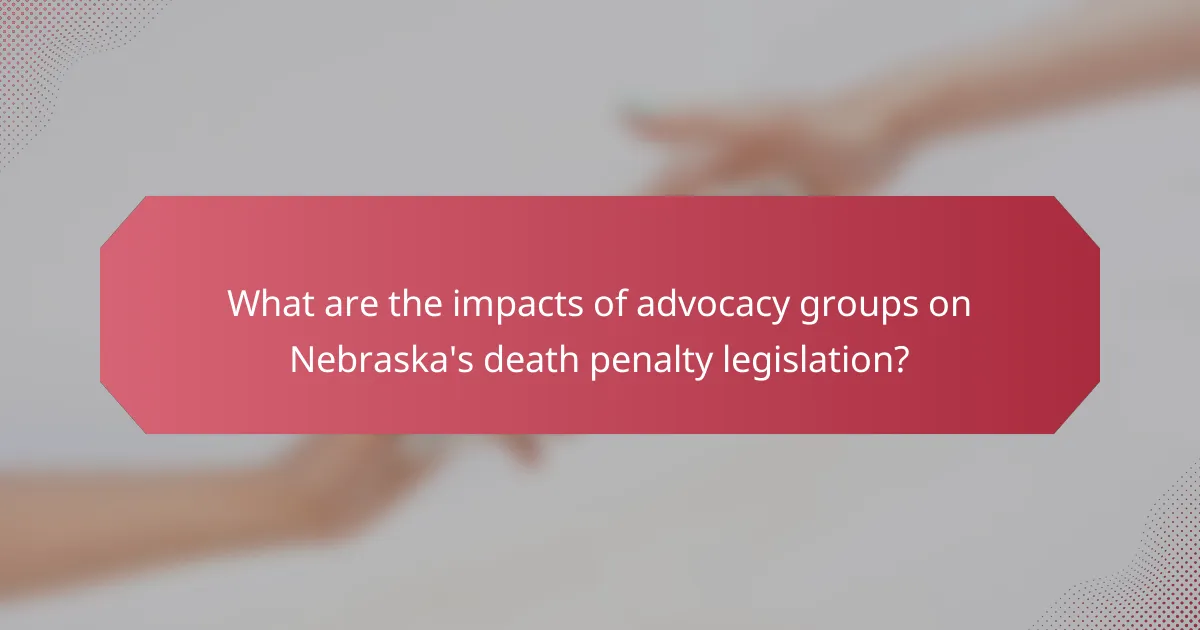
What are the impacts of advocacy groups on Nebraska’s death penalty legislation?
Advocacy groups significantly influence Nebraska’s death penalty legislation. They mobilize public opinion against capital punishment. These groups often provide research and statistics highlighting the costs and moral implications of the death penalty. Their campaigns can lead to increased legislative scrutiny and debate. For instance, in 2015, advocacy efforts contributed to the repeal of the death penalty in Nebraska. Although the repeal was later overturned, the advocacy groups’ persistent efforts kept the issue alive in public discourse. Their lobbying efforts often result in legislative proposals aimed at reform or abolition. Overall, advocacy groups play a crucial role in shaping the legislative landscape surrounding the death penalty in Nebraska.
How have advocacy groups shaped legislative outcomes regarding the death penalty?
Advocacy groups have significantly influenced legislative outcomes regarding the death penalty. They have mobilized public opinion against capital punishment. Campaigns led by organizations like the American Civil Liberties Union have highlighted issues of wrongful convictions and racial bias. These groups have provided data and personal testimonies to lawmakers. They also engage in grassroots organizing to build coalitions. In Nebraska, advocacy efforts contributed to the repeal of the death penalty in 2015. The repeal was passed by the legislature and later vetoed by the governor. Advocacy groups continued to push for the repeal, demonstrating public support through petitions and rallies. Their sustained efforts led to the eventual reinstatement of a moratorium on executions.
What specific laws or policies have been influenced by advocacy efforts?
The Nebraska Death Penalty Repeal Act of 2015 was influenced by advocacy efforts. Advocacy groups like Nebraskans for Alternatives to the Death Penalty played a significant role. They mobilized public opinion against capital punishment. Their campaign included petitions and educational initiatives. This led to the Nebraska Legislature voting to repeal the death penalty. Governor Pete Ricketts vetoed the repeal, but the Legislature overrode it. This marked a significant shift in Nebraska’s approach to capital punishment. Advocacy efforts directly contributed to the legal change in the state’s death penalty policy.
How do advocacy groups respond to changes in legislation?
Advocacy groups respond to changes in legislation by mobilizing their members and the public. They analyze the implications of new laws and adjust their strategies accordingly. This often includes lobbying lawmakers to influence future legislation. Advocacy groups may also engage in public awareness campaigns to inform citizens about the changes. They use social media and traditional media to disseminate information quickly. Additionally, they may collaborate with other organizations to strengthen their efforts. For example, during the Nebraska death penalty debate, groups actively organized rallies and petitions. These actions aim to sway public opinion and encourage legislative reconsideration.
What role do advocacy groups play in educating the public about the death penalty?
Advocacy groups play a crucial role in educating the public about the death penalty. They provide information on the moral, legal, and social implications of capital punishment. These groups often conduct research and publish reports highlighting the flaws in the death penalty system. For instance, studies show that wrongful convictions can occur, with the Innocence Project reporting over 20 exonerations in death penalty cases. Advocacy groups also organize campaigns to raise awareness and promote discussions in communities. They utilize social media platforms to reach a wider audience and engage the public in dialogue. Furthermore, these organizations often collaborate with legal experts to present factual arguments against the death penalty. Through educational workshops and public speaking events, they aim to inform citizens about alternative sentencing options. Overall, advocacy groups significantly influence public perception and policy regarding the death penalty.
What educational initiatives are led by advocacy groups?
Advocacy groups lead various educational initiatives focused on the death penalty. These initiatives often include public awareness campaigns. They aim to inform the community about the implications of capital punishment. Educational materials are developed to provide factual information. Workshops and seminars are organized to facilitate discussions on the topic. Advocacy groups also engage in outreach programs in schools and communities. They collaborate with legal experts to offer insights on the justice system. Research studies are conducted to highlight the effects of the death penalty on society. These efforts aim to influence public opinion and policy regarding capital punishment.
How effective are these initiatives in changing public perceptions?
These initiatives are effective in changing public perceptions regarding the death penalty. Advocacy groups in Nebraska have successfully influenced opinions through targeted campaigns. Research indicates that public awareness campaigns can shift views on capital punishment. For example, a study by the Pew Research Center found that states with active advocacy efforts saw a decrease in support for the death penalty. Additionally, personal stories shared by advocacy groups resonate with the public, fostering empathy and understanding. Surveys conducted post-campaign show measurable changes in attitudes towards the death penalty. These findings demonstrate that advocacy initiatives can significantly alter public perceptions over time.
How can individuals support advocacy groups in the death penalty debate?
Individuals can support advocacy groups in the death penalty debate by donating funds. Financial contributions help sustain operations and outreach efforts. Volunteers can also offer their time to assist with campaigns. Engaging in community events raises awareness about the issues involved. Sharing information on social media amplifies the message of advocacy groups. Writing to local representatives can influence policy decisions regarding the death penalty. Attending rallies or demonstrations shows public support for the cause. Lastly, educating oneself and others about the implications of the death penalty fosters informed discussions.
What actions can individuals take to get involved?
Individuals can participate in advocacy efforts regarding Nebraska’s death penalty debate. They can join local advocacy groups focused on criminal justice reform. Volunteering time for events or campaigns helps raise awareness. Attending town hall meetings allows individuals to voice their opinions. Engaging in social media campaigns can amplify their message. Donating to organizations supporting abolition efforts provides financial support. Writing letters to lawmakers influences policy decisions. Educating themselves and others about the issues fosters informed discussions. Each of these actions contributes to the broader movement against the death penalty in Nebraska.
How can grassroots movements amplify the efforts of advocacy groups?
Grassroots movements can amplify the efforts of advocacy groups by increasing public engagement and awareness. They mobilize community members to participate in campaigns. This leads to a broader base of support for advocacy initiatives. Grassroots efforts often utilize social media to spread messages quickly. For example, the #AbolishTheDeathPenalty campaign in Nebraska gained traction through grassroots mobilization. Increased visibility can attract media attention, further enhancing advocacy efforts. Additionally, grassroots movements can provide a platform for personal stories, making issues more relatable. This emotional connection can influence public opinion and policy decisions.
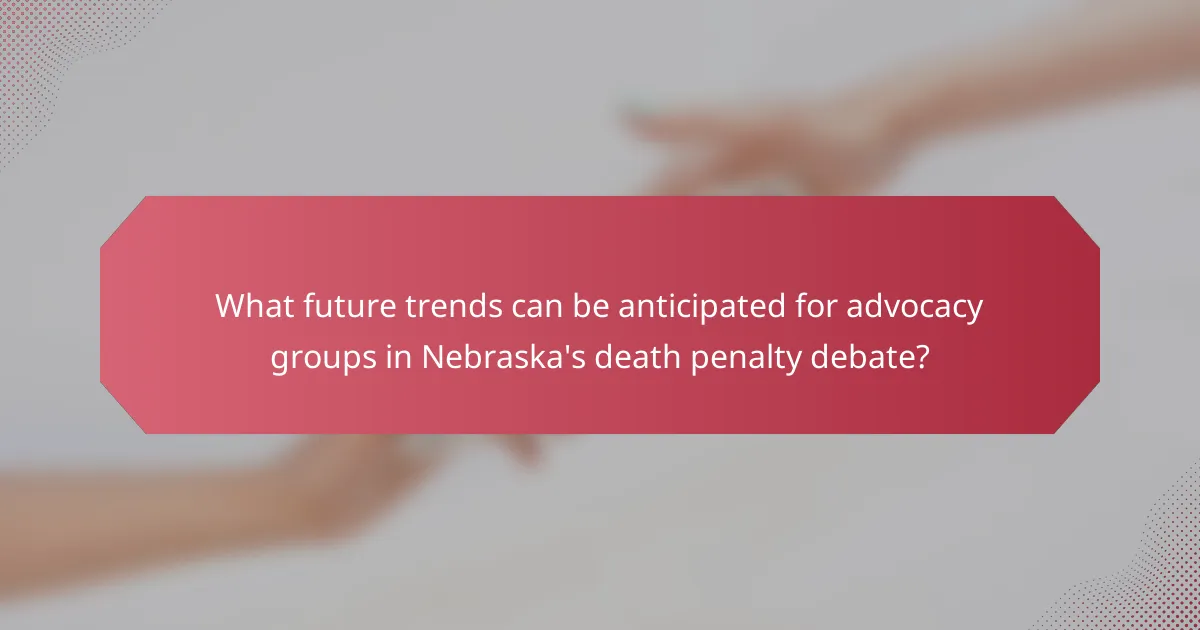
What future trends can be anticipated for advocacy groups in Nebraska’s death penalty debate?
Advocacy groups in Nebraska’s death penalty debate are likely to focus on increased public awareness and engagement. They may leverage social media to mobilize supporters and share information. Collaborations with national organizations could enhance their resources and strategies. Legal challenges against the death penalty may become more prominent as public opinion shifts. Data-driven campaigns highlighting wrongful convictions could influence discussions. Additionally, mental health and rehabilitation arguments may gain traction among these groups. Legislative lobbying efforts may intensify as elections approach. Historical patterns show that advocacy groups adapt to societal changes, suggesting a dynamic future in this debate.
How might public attitudes toward the death penalty evolve in Nebraska?
Public attitudes toward the death penalty in Nebraska may evolve due to ongoing advocacy efforts. Advocacy groups are actively campaigning for reform and raising awareness about the moral implications of capital punishment. Recent polling indicates a shift in public opinion, with more residents questioning its effectiveness and fairness. Additionally, high-profile cases and wrongful convictions have sparked discussions about the death penalty’s reliability. Legislative changes and national trends towards abolition could further influence local perspectives. As these advocacy efforts continue, it is likely that public sentiment will increasingly favor alternatives to capital punishment.
What factors could influence future advocacy strategies?
Future advocacy strategies could be influenced by public opinion shifts regarding the death penalty. Changes in societal values can significantly impact advocacy approaches. Legislative developments also play a crucial role in shaping these strategies. For instance, recent bills or court rulings can alter the landscape for advocacy groups. Increased access to information through social media can enhance outreach efforts. The effectiveness of past campaigns can inform future tactics and messaging. Collaboration with other organizations can broaden influence and resource sharing. Finally, funding availability can determine the scope and scale of advocacy initiatives.
How can advocacy groups adapt to changing social dynamics?
Advocacy groups can adapt to changing social dynamics by employing flexible communication strategies. These strategies include utilizing social media platforms to reach diverse audiences. They can also conduct research to understand shifting public opinions on issues like the death penalty. Engaging with community leaders enhances their ability to resonate with local values. Additionally, forming coalitions with other organizations can amplify their impact. Advocacy groups should also be prepared to modify their messaging based on current events. Regularly assessing their strategies ensures they remain relevant and effective. Data shows that organizations that adapt their approaches see increased support and engagement.
What best practices should advocacy groups follow in their efforts?
Advocacy groups should focus on clear messaging and community engagement. Clear messaging ensures that the group’s goals and values are easily understood. It helps in mobilizing support and fostering awareness. Community engagement builds trust and relationships with stakeholders. Engaging local communities can lead to more effective advocacy efforts.
Data-driven strategies enhance credibility. Utilizing research and statistics can substantiate claims and arguments. Collaborating with experts can provide valuable insights. Building coalitions with other organizations amplifies the group’s voice. Collaborative efforts can lead to broader support and resources.
Regularly evaluating strategies improves effectiveness. Assessing outcomes helps identify successful tactics and areas for improvement. Transparency in operations fosters accountability. Being open about goals and methods can attract more supporters.
Incorporating storytelling can humanize issues. Personal narratives resonate with audiences and evoke empathy. Advocacy groups should also leverage social media for outreach. Online platforms can increase visibility and engagement.
How can advocacy groups effectively measure their impact?
Advocacy groups can effectively measure their impact by utilizing specific metrics and evaluation methods. They should establish clear goals and objectives at the onset of their campaigns. Tracking changes in public opinion through surveys can provide quantifiable data on awareness and support. Additionally, analyzing legislative outcomes related to their advocacy efforts offers concrete evidence of influence. Gathering testimonials from individuals affected by their initiatives can highlight personal stories of change. Monitoring social media engagement and outreach effectiveness can also reflect their reach and resonance. Lastly, partnerships with academic institutions for research studies can provide rigorous evaluations of their impact.
What are the key elements of successful advocacy campaigns?
Successful advocacy campaigns include clear objectives, targeted messaging, and strong community engagement. Clear objectives define the campaign’s purpose and desired outcomes. Targeted messaging resonates with the audience and highlights the campaign’s key issues. Strong community engagement fosters support and mobilizes action. Research shows that campaigns with these elements are more likely to influence public opinion and policy. For example, the American Civil Liberties Union (ACLU) effectively used these strategies in their advocacy against the death penalty in various states.
The main entity of this article is advocacy groups involved in Nebraska’s death penalty debate. The article provides an overview of the influence these groups have on public opinion and legislative outcomes regarding capital punishment in Nebraska. It details their strategies for mobilizing supporters, the challenges they face, and the key organizations involved in the discussion. Additionally, the article examines the impact of advocacy efforts on legislation, public education initiatives, and the evolving attitudes toward the death penalty within the state.
